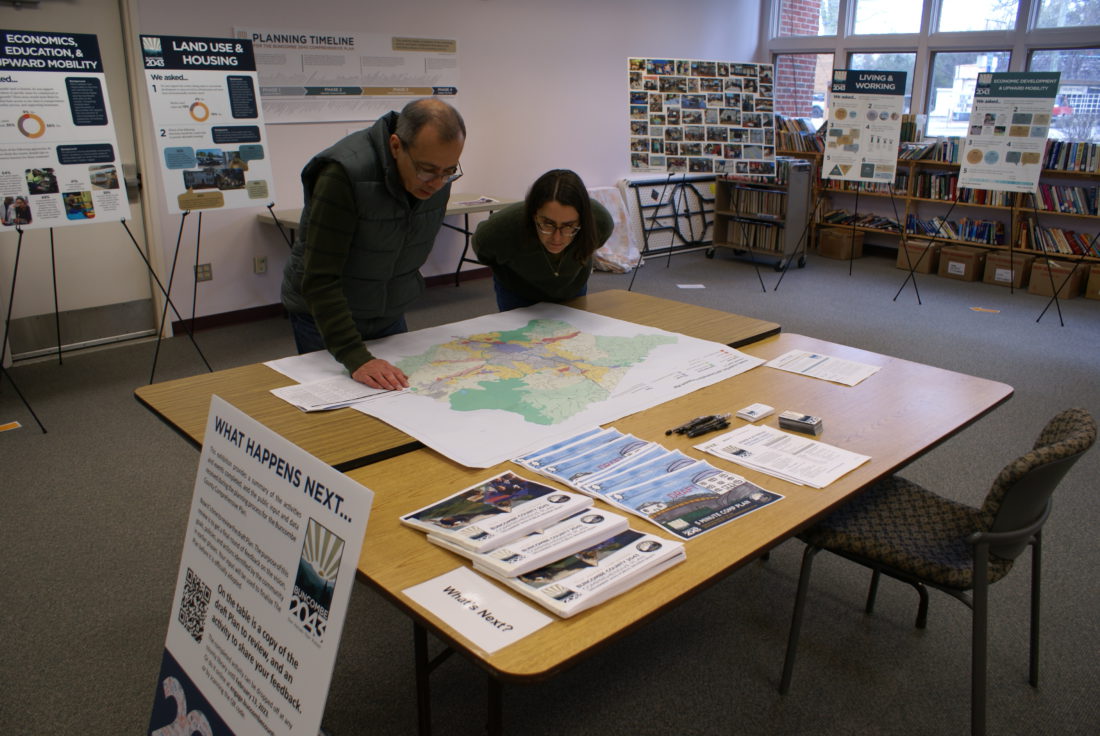By Sean Connor
Ask a child what Buncombe County should look like in 20 years, and the responses will range from the hilarious to the heartfelt.
Sam, age 9, wants an arcade with a pool, a free ice cream parlor and an “awsom bilding” with free gum and Nerf guns. Sidney, age 4, wishes the county had more playgrounds. Maya, age 10, hopes residents will care more about the environment and stop littering.
Their responses were among the roughly 200 collected on postcards from kids as part of Buncombe’s comprehensive planning process. The county’s first such effort of its kind is meant to inform land use policy, infrastructure, community services and other local government efforts over the next two decades.
The draft plan, released in December, is now in the fourth and last phase of its development. County officials are seeking a final round of input from the community before the plan’s approval by the Planning Board and Board of Commissioners, currently slated for May.

“We are asking that residents review the details of the draft and provide feedback on whether or not we got it right,” says Gillian Phillips, Buncombe’s long-range planning division manager.
Collaborate and listen
Phillips says the community has been helping to shape the plan since work began in the fall of 2021,. Input started with residents being asked to list up to five words or phrases that best described their visions for the county in 20 years, and multiple polls on the plan have been posted to the Engage Buncombe online feedback portal.
Through the first three phases of the process, says Phillips, over 2,900 residents participated. Beyond the online activities, opportunities to comment included 14 in-person, drop-in or virtual meetings specifically about the plan, 36 community outreach events and 75 relevant board and committee meetings.
Buncombe also made a point of reaching out to youths, both through the postcard project and by visiting county and city schools. Since the plan covers a span of 20 years, Phillips adds, getting young people involved was critical. “It’s apparent from the conversations we had with the kids that they are smart and will let you know what’s important to them if you ask,” she says.
Elementary students, Philips continues, were overwhelmingly in favor of more community swimming pools. Middle schoolers, she says, tended to focus on environmental issues and land use.
“I think the county has done an exceptional job in getting people’s voices heard,” says Nancy Waldrop, who sat on the plan’s 23-member steering committee and chairs the county Planning Board. (The committee disbanded in December 2022 after completing its official duties.) She says she was particularly impressed by the diverse representation on the steering committee and credits her colleagues with driving a lot of community engagement.
Buncombe speaks
Among the most pressing issues highlighted by the community, according to the data and several of the plan’s leaders, are lack of affordable housing, lack of public transportation and losing natural areas and agricultural lands to new development. The biggest concern, flagged by 67% of residents surveyed, is rising cost of living.
Andrea Golden helped represent that concern through her seat on the steering committee. As the co-director of PODER Emma, a community group working to prevent the displacement of mobile home residents from the Emma neighborhood, she wanted to ensure “the plan speaks both to the current realities and for people’s vision for the future.”
“Before I joined the committee, we conducted an extensive neighborhood-based research project, where we talked to a few hundred people to make sure we were bringing the most pressing perspective,” she says. “And for our community, the No. 1 need expressed was affordable housing.”
Kit Cramer, another steering committee member and president and CEO of the Asheville Area Chamber of Commerce, says she focused mainly on the business community and “ensuring that their voice is heard.” She sees current land restrictions in Buncombe County and access to child care as some of the main challenges facing local entrepreneurs.
Cramer also emphasized the importance of working with other counties in the region to manage Buncombe’s growth. She said over 56,000 people come from 12 surrounding counties to work in Buncombe each day; that worker influx has increased by 25% between 2009 and 2019.
“We’re lucky to be dealing with issues of growth as opposed to the other way around,” adds Cramer.
What’s next?
The draft plan Buncombe wants residents to examine stands at nearly 200 pages. Reviewing such a large document can be daunting, but steering committee member Jennifer Caldwell-Billstrom identifies a few starting points for those looking to weigh in.
“I encourage neighbors to dig into the vision themes and goals presented in the draft plan,” she says, as well as review its growth, equity and conservation map, which is a tool for assessing future land use and zoning changes. The executive summary of the plan includes all of those items and runs to a more digestible 15 pages.
To participate in the process, residents can visit avl.mx/cbe. The Engage Buncombe portal includes a new survey on the plan, a virtual exhibit on the work so far and details about upcoming in-person engagement opportunities. The deadline to offer feedback is Monday, Feb. 13.
One of the county’s main goals, says Waldrop, was to get quality feedback from as many residents as possible and to gain a better understanding of what their community’s future looks like to them. “I am thrilled,” she says, “because I think that’s happened.”



Before you comment
The comments section is here to provide a platform for civil dialogue on the issues we face together as a local community. Xpress is committed to offering this platform for all voices, but when the tone of the discussion gets nasty or strays off topic, we believe many people choose not to participate. Xpress editors are determined to moderate comments to ensure a constructive interchange is maintained. All comments judged not to be in keeping with the spirit of civil discourse will be removed and repeat violators will be banned. See here for our terms of service. Thank you for being part of this effort to promote respectful discussion.